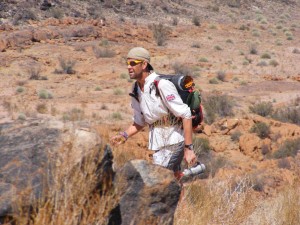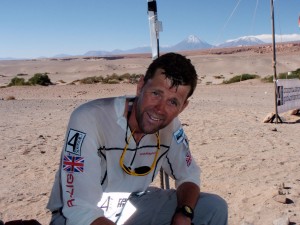Dave Berridge has completed some of the world’s most extreme ultra-endurance events, including winning the epic 352-mile 6633 ultra in 2013. He’s conquered Kilimanjaro and raced around the Moroccan desert, the Himalayas and the Arctic. Graeme Harvey caught up with him at the recent National Adventure Awards.
What got you started?
At the age of 34, bored with my job, I watched a short clip about the Marathon Des Sables and it fascinated me; I thought, “These guys are superhuman!” But they were ordinary people like me, with jobs and families and I thought I’d love to have a go. I signed up, finished it and I’ve been racing ever since. I’ve now raced across the Atacama Desert, the Kalahari, I’ve raced in the Arctic in the Yukon Arctic Ultra 430-mile and 350-mile races and the 352-mile 6633 Ultra. I’ve also raced in Siberia and the Himalayas.
Which has been the toughest?
The Yukon Arctic Ultra 430-mile race – even before I started I thought it was way too big for me. Temperatures reached – 61 degrees, I had frostbitten feet, a frostbitten ear – I really struggled – but, by the skin of my teeth, I finished. They’re all mentally tough. It’s more mental than physical.
How do you get through the tough times?
I use every trick in the book. Experience has taught me that the tough times are only temporary. You’ve got to plug away and stick at it. I set myself little quizzes, finish books that I’ve started and not finished in my head, plan gardening projects and finish courses I’ve started – anything to keep my mind occupied. It’s crazy but I’m usually planning my next event as well! I’ve learned that it doesn’t matter how painful it is or how bad it is, because it will pass and you’ll get through it. The pain goes but you’ll have the satisfaction and glory of finishing a race like this – and that lasts forever.
How do you train for these distances?
In the run-up to a big race, I run three times a day. I do a long run in the morning, which is usually 11-12 miles. Later I also do a shorter run, which is 8-9 miles. Then I do a mile on the treadmill on the highest incline, as fast as I can. Running once a day doesn’t replicate race conditions, i.e you get to a checkpoint rest for half an hour then you get going again, so that’s why I train three times a day so my body doesn’t shut down – it’s ready for the next run and the next one. If I was to train once a day, my body would sit there and think I’ve finished – but it’s got to get going again – just like at a checkpoint. I do this four times a week and that will be from 6-8 weeks in the run-up to a big race, depending on the event. Prior to that, it’s usually two runs a day – 10.1 miles to work and back again.
 What advice would you give to someone thinking of trying these distances?
What advice would you give to someone thinking of trying these distances?
Patience. The secret of running a long way over a long period of time is to go at a pace that you can maintain. So if you stop, you know you can get going again. It’s just patience and, as I say to guys at work, “It’s easy, just run slowly.” To them, a race means running fast. For me, I’m not racing anyone – I’m just trying to reach a finish line and if I’m doing 10 days’ running, I know I need to go really slowly! But I’m constant and I’ll keep it up; that’s how I’ve been successful in my races. I always start at the back, then I just slowly work my way up the field. It’s another psychological thing; if you see someone ahead who you are gaining on, it’s better than seeing people overtaking you.
So what’s next?
In June I’m off to the Gobi desert to race, and then hopefully I’ll be off to Iditarod in the USA to race, but then who knows?
Dave Berridge is the author of Fartleks and Flatulence, available in Paperback and Kindle via Amazon and http://www.daveberridge.co.uk/home.html






